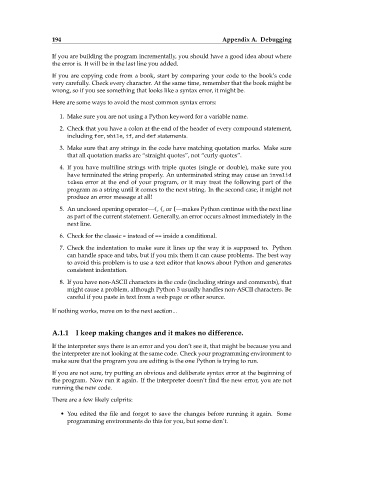Page 216 - thinkpython
P. 216
194 Appendix A. Debugging
If you are building the program incrementally, you should have a good idea about where
the error is. It will be in the last line you added.
If you are copying code from a book, start by comparing your code to the book’s code
very carefully. Check every character. At the same time, remember that the book might be
wrong, so if you see something that looks like a syntax error, it might be.
Here are some ways to avoid the most common syntax errors:
1. Make sure you are not using a Python keyword for a variable name.
2. Check that you have a colon at the end of the header of every compound statement,
including for, while , if, and def statements.
3. Make sure that any strings in the code have matching quotation marks. Make sure
that all quotation marks are “straight quotes”, not “curly quotes”.
4. If you have multiline strings with triple quotes (single or double), make sure you
have terminated the string properly. An unterminated string may cause an invalid
token error at the end of your program, or it may treat the following part of the
program as a string until it comes to the next string. In the second case, it might not
produce an error message at all!
5. An unclosed opening operator—(, {, or [—makes Python continue with the next line
as part of the current statement. Generally, an error occurs almost immediately in the
next line.
6. Check for the classic = instead of == inside a conditional.
7. Check the indentation to make sure it lines up the way it is supposed to. Python
can handle space and tabs, but if you mix them it can cause problems. The best way
to avoid this problem is to use a text editor that knows about Python and generates
consistent indentation.
8. If you have non-ASCII characters in the code (including strings and comments), that
might cause a problem, although Python 3 usually handles non-ASCII characters. Be
careful if you paste in text from a web page or other source.
If nothing works, move on to the next section...
A.1.1 I keep making changes and it makes no difference.
If the interpreter says there is an error and you don’t see it, that might be because you and
the interpreter are not looking at the same code. Check your programming environment to
make sure that the program you are editing is the one Python is trying to run.
If you are not sure, try putting an obvious and deliberate syntax error at the beginning of
the program. Now run it again. If the interpreter doesn’t find the new error, you are not
running the new code.
There are a few likely culprits:
• You edited the file and forgot to save the changes before running it again. Some
programming environments do this for you, but some don’t.

